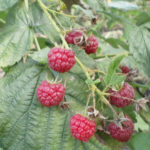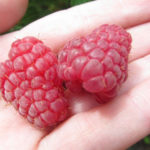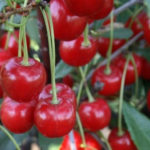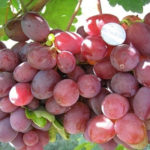Chardonnay grape variety
The magnificent and well-known technical white grape variety Chardonnay belongs to those classic varieties from which for many centuries in Europe and then beyond its borders, exceptional quality, world-famous wines have been made. Its homeland today is the French province of Burgundy, and the name is inherited from the local village of the same name. Scientists have long argued about the origin of our hero, putting forward a wide variety of versions, but a DNA analysis carried out in 1998 by the University of California at Davis put an end to the lingering controversy. According to scientists, confirmed by genetic studies, the old French variety became the immediate parents of the new form. Pinot and Portuguese - Gue Blanc. Hybridization most likely occurred spontaneously in an area where both varieties grew adjacent to each other.
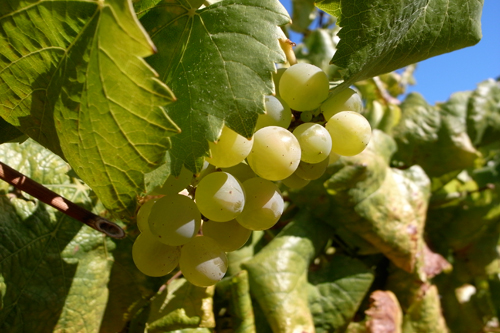
During its centuries-old history, our hero has spread throughout the entire globe. The largest areas occupied under it are currently located in France, USA, Australia, Italy, Georgia, Moldova, South Africa and a number of other countries with a developed wine industry. In total, about 175 thousand hectares of Chardonnay are grown on the globe, and for this indicator it is included in the list of the most common forms of grapes. Due to such a wide geography, as well as due to the presence of many clones, the name of the variety has many synonyms by which it is known in certain areas.
The popularity of our hero is due to his relative unpretentiousness among the representatives of the Western European ecological-geographical group of the species Vitis vinifera, high plasticity and easy adaptation to new growing conditions, as well as the versatility of harvest processing methods. The wines produced from these grapes can be very diverse - dry and dessert, still and sparkling, table and fortified, young and aged. At the same time, all of them are united by excellent quality, bright memorable taste and unique bouquet. They never leave true connoisseurs of good drinks indifferent.
Agrobiological characteristics
The bushes are characterized by medium vigor. The crown of a young shoot is light green with noticeable spots of pink tones, has a cobweb pubescence of moderate intensity. The leaves are not too large, rounded, with five slightly dissected lobes that bend downward. The upper side cutouts, most often, are in the form of a reentrant angle, less often - lyre-shaped. The lower notches are faintly visible, and in some cases are completely absent. The petiole notch is open, lancet or vaulted with a bottom, often limited by veins. The petioles are short. The surface of the leaf is roughly wrinkled, the color is green, the reverse side is slightly pubescent. The denticles along the edges of the leaf blade are triangular, convex on one side, differ significantly from each other in size. The flowers of the variety are bisexual, but this does not prevent the peas of berries in unfavorable years for flowering conditions. In addition, Chardonnay has a certain tendency to shedding the ovary. Annual growth ripens well - 90% of its length. In autumn, before falling off, the foliage of the grapes turns lemon yellow.
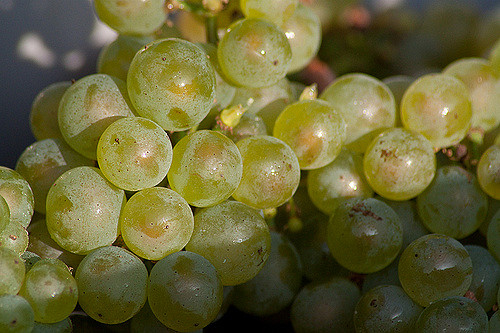
The bunches grow small - 12-13 cm long, and 9-10 cm wide. Their shape is conical or cylindro-conical, and the structure is very diverse - from dense to very loose. The average weight of ripe brushes does not exceed 100 grams. They are attached to the vine with a short lignified comb. The berries are round or barely oval, medium in size, their diameter ranges from 12 to 16 mm, and their weight is from 1.2 to 1.5 grams. The skin is thin, but strong, tinged greenish-white with a golden tan on the sunlit side, a light layer of protective prune and numerous small brown dots are visible on the surface.The pulp is juicy, tasty, has an intense varietal aroma. The juice yield during processing exceeds 74% of the crop mass, the skin and dense parts of the pulp are about 20%, the ridges - 3%. The number of seeds in the berries of this variety does not exceed two or three; in terms of mass, their share also fluctuates around 3%. The sugar content in freshly squeezed wort is 18-23 g / 100 ml, titratable acidity is 8-11 g / l.
As already mentioned, there are many directions and methods of processing grapes that are excellent in terms of technology. Winemakers joke that it is impossible to make bad wine from Chardonnay, even if you try. However, the yield and the properties of the drinks made from it can vary from region to region, since the variety clearly reflects the characteristics of the soil and climate of the area in which it grows. Varietal wine most often has aromas of peach, lemon, apple and tropical fruits in its bouquet. During aging, oak tones are clearly manifested, which are extracted from the riveting in a barrel. The most interesting drinks with a rare "mineral" bouquet are obtained from grapes grown on poor soils in cool regions. At the same time, our hero's own distinctive qualities are so graceful that they immediately fade when combined with other varieties, only from a distance supplementing the general aroma with their subtle notes. At home, in France, it is from it, in a blend with Pinot noir, that the classic champagne of the best brands is produced.

The ripening of the crop occurs in the middle late period, usually the harvest begins at the end of September, but can also occur later, when the goal, for example, is processing into dessert wines. If we count from the moment of budding, then by the time of the onset of technical ripeness, 135-140 days pass. The sum of active temperatures required to obtain ripe bunches of grapes reaches 2700-2800 ° C. With such indicators, the variety, unfortunately, cannot grow north of the traditional wine-growing regions, and in our country it is zoned only in the North Caucasus, in particular, in the Krasnodar Territory and the Republic of Adygea. Plants here show good drought tolerance, but they can withstand the winter cold on average. The frost resistance of bushes uncovered in autumn does not exceed -20 ° С.
With amazing product quality, Chardonnay, as is often the case with exquisite varieties, does not shine with the volume of the harvest. Only 40% of its shoots turn out to be fruitful, and the situation is saved only by the fact that 2-3 bunches can be simultaneously laid on productive vines. The average fruiting factor is 1.1, and the fruiting factor is 1.5-1.7. Replacement buds can also form a crop, which is of no small importance due to the early blooming of the main eyes and their frequent freezing due to this. Overloading the bushes with grapes is virtually impossible. Moreover, the grower will have to apply all his experience in order to sufficiently load them with the harvest, and not with useless vegetative mass. In the most advanced farms, up to 80-120 centners of bunches, or 60-90 hectoliters of squeezed wort, are obtained from a hectare of vineyard.
With a long stay of ripening grapes on the vine, it must be borne in mind that the berries are prone to cracking and decay in the event of rainy weather. In addition, they can be damaged by wasps, and for protection you will have to use something less laborious than individual bags, where usually bunches of table varieties are placed. In particular, special traps hung in the vineyard, or containers with sugar syrup, in which pests drown, are suitable against insects. In general, it is recommended to plan a late collection only in those areas where the autumn is warm and dry for a long time.
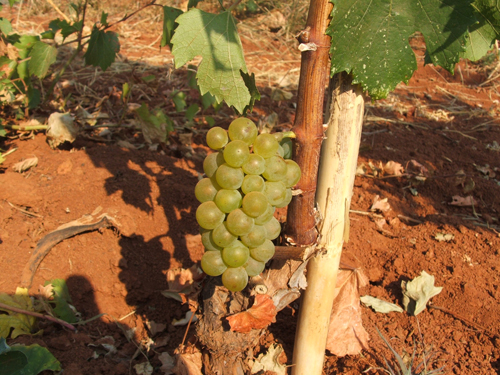
Agrotechnical features
Despite the fact that this grape is very versatile, certain preferences for the growing conditions of the plant still show. The best results in terms of the quality of the wines obtained are obtained by cultivating Chardonnay on stony and lime-clay soils. The terrain also has a certain value, and from this point of view, it is better to place the vineyard on the slopes of the western or south-western exposure, as well as gentle hills.
Reproduction is carried out mainly by grafted seedlings using phylloxera-resistant rootstocks, because in traditional cultivation regions, the soil is usually infested with harmful root aphids. Fusion of the variety best occurs with such rootstock forms as Riparia x Rupestris 101-14, Berlandieri x Riparia CO4 and Berlandieri x Riparia Kober 5BB. Approximate grape planting scheme 2.5 × 1.5 m.
The form of bushes management - covering or non-covering, is chosen depending on the frost hazard of the local climate. If insulation is not required for the winter, then the best option would be to remove a high-standard formation with a free location of one-year growth. At the same time, the width of the row spacing is provided in advance more than usual. In the covering zones, appropriate formations of the Guyot type, a multi-arm fan or an inclined cordon with a vertical garter of shoots on a trellis are used.
Spring pruning of Chardonnay takes a long time - for 10-12 eyes, the total load on the bush can reach up to 50 buds. During the grape fragments, numerous sterile shoots should be removed, keeping some of them only when the plants are clearly underloaded with the harvest.
Against fungal diseases, multiple treatments with fungicides will be required according to protection schemes for varieties susceptible to common pathogens.

